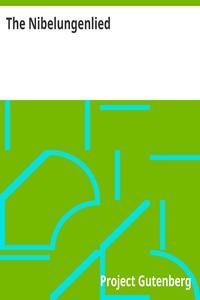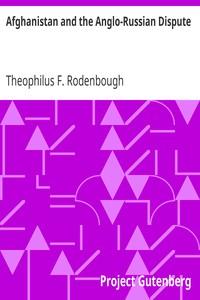Read this ebook for free! No credit card needed, absolutely nothing to pay.
Words: 119060 in 100 pages
This is an ebook sharing website. You can read the uploaded ebooks for free here. No credit cards needed, nothing to pay. If you want to own a digital copy of the ebook, or want to read offline with your favorite ebook-reader, then you can choose to buy and download the ebook.


: The Nibelungenlied Translated into Rhymed English Verse in the Metre of the Original by Needler G H George Henry Translator - Epic poetry German Translations into English
INTRODUCTION.
THE NIBELUNGENLIED.
THE NIBELUNGENLIED
All the Aryan peoples have had their heroic age, the achievements of which form the basis of later saga. For the Germans this was the period of the Migrations, as it is called, in round numbers the two hundred years from 400 to 600, at the close of which we find them settled in those regions which they have, generally speaking, occupied ever since. During these two centuries kaleidoscopic changes had been taking place in the position of the various Germanic tribes. Impelled partly by a native love of wandering, partly by the pressure of hostile peoples of other race, they moved with astonishing rapidity hither and thither over the face of Europe, generally in conflict with one another or buffeted by the Romans in the west and south, and by the Huns in the east. In this stern struggle for existence and search for a permanent place of settlement some of them even perished utterly; amid the changing fortunes of all of them deeds were performed that fixed themselves in the memory of the whole people, great victories or great disasters became the subject of story and song. We need only to recall such names as those of Ermanric and Theodoric to remind ourselves what an important part was played by the Germanic peoples of that Migration Period in the history of Europe. During it a national consciousness was engendered, and in it we have the faint beginnings of a national literature. Germanic saga rests almost entirely upon the events of these two centuries, the fifth and sixth. Although we get glimpses of the Germans during the four or five preceding centuries, none of the historic characters of those earlier times have been preserved in the national sagas.
With these sagas based on history, however, have been mingled in most cases primeval Germanic myths, possessions of the people from prehistoric times. A most conspicuous example of this union of mythical and originally historical elements is the Nibelungen saga, out of which grew in course of time the great national epic, the Nibelungenlied.
The Nibelungen saga is made up of two parts, on the one hand the mythical story of Siegfried and on the other the story, founded on historic fact, of the Burgundians. When and how the Siegfried myth arose it is impossible to say; its origin takes us back into the impenetrable mists of the unrecorded life of our Germanic forefathers, and its form was moulded by the popular poetic spirit. The other part of the saga is based upon the historic incident of the overthrow of the Burgundian kingdom by the Huns in the year 437. This annihilation of a whole tribe naturally impressed itself vividly upon the imagination of contemporaries. Then the fact of history soon began to pass over into the realm of legend, and, from causes which can no longer be determined, this tradition of the vanished Burgundians became united with the mythical story of Siegfried. This composite Siegfried-Burgundian saga then became a common possession of the Germanic peoples, was borne with many of them to lands far distant from the place of its origin, and was further moulded by each according to its peculiar genius and surroundings. In the Icelandic Eddas, the oldest of which we have as they were written down in the latter part of the ninth century, are preserved the earliest records of the form it had taken among the northern Germanic peoples. Our Nibelungenlied, which is the chief source of our knowledge of the story as it developed in Germany, dates from about the year 1200. These two versions, the Northern and the German, though originating in this common source, had diverged very widely in the centuries that elapsed between their beginning and the time when the manuscripts were written in which they are preserved. Each curtailed, re-arranged, or enlarged the incidents of the story in its own way. The character of the chief actors and the motives underlying what we may call the dramatic development assumed widely dissimilar forms. The German Nibelungenlied may be read and appreciated as one of the world's great epic poems without an acquaintance on the part of the reader with the Northern version of the saga. In order, however, to furnish the setting for a few episodes that would in that case remain either obscure or colorless, and with a view to placing the readers of this translation in a position to judge better the deeper significance of the epic as the eloquent narrative of a thousand years of the life of the people among whom it grew, the broad outlines of the saga in its Northern form will be given here.
On their wanderings through the world the three gods Odin, Honir, and Loki come to a waterfall where an otter is devouring a fish that it has caught. Loki kills the otter with a stone, and they take off its skin. In the evening they seek a lodging at the house of Hreidmar, to whom they show the skin. Hreidmar recognizes it as that of his son, whom Loki has killed when he had taken on the form of an otter. Assisted by his sons Fafnir and Regin, Hreidmar seizes the three gods, and spares their lives only on the promise that they will fill the skin, and also cover it outwardly, with gold. Loki is sent to procure the ransom. With a net borrowed from the sea-goddess Ran he catches at the waterfall the dwarf Andvari in form of a fish and compels him to supply the required gold. Andvari tries to keep back a ring, but this also Loki takes from him, whereupon the dwarf utters a curse upon the gold and whosoever may possess it. The ransom is now paid to Hreidmar; even the ring must, on Hreidmar's demand, be given in order to complete the covering of the otter's skin. Loki tells him of the curse connected with the ownership of the gold. When Hreidmar refuses Fafnir and Regin a share in the treasure, he is killed by Fafnir, who takes possession of the hoard to the exclusion of Regin. In the form of a dragon Fafnir dwells on Gnita Heath guarding the hoard, while Regin broods revenge.
From Odin is descended King Volsung, who has a family of ten sons and one daughter. The eldest son is Sigmund, twin-born with his sister Signy. King Siggeir of Gautland sues for the hand of Signy, whom her father gives to Siggeir against her will. In the midst of King Volsung's hall stood a mighty oak-tree. As the wedding-feast is being held there enters a stranger, an old man with one eye, his hat drawn down over his face and bearing in his hand a sword. This sword he thrusts to the hilt into the tree, saying that it shall belong to him who can draw it out again; after which he disappears as he had come. All the guests try their strength in vain upon the sword, but Sigmund alone is able to draw it forth. He refuses to sell it to Siggeir for all his proffered gold. Siggeir plans vengeance. He invites Volsung and his sons to Gautland, and returns home thither with his bride Signy, who before going warns her father to be upon his guard.
To Sigmund, who has hidden in a wood, Signy sends her eldest boy of ten years that Sigmund may test his courage and see if he is fit to be a helper in seeking revenge. Neither he, however, nor his younger brother stands the test. Signy sees that only a scion of the race of Volsung will suffice, and accordingly disguises herself and lives three days with Sigmund in the wood. From their union a son Sinfiotli is born, whom also, after ten years, she sends out to Sigmund. He stands every test of courage, and is trained by Sigmund, who thinks he is Siggeir's son.
Bent on revenge, Sigmund repairs with Sinfiotli to Siggeir's castle. After Sinfiotli has slain the king's two sons, he and Sigmund are overpowered and condemned to be buried alive. With Sigmund's sword, however, which Signy has managed to place in their hands, they cut their way out, then set fire to Siggeir's hall. Signy comes forth and reveals to Sigmund that Sinfiotli is their own son; and then, saying that her work of revenge is complete and that she can live no longer, she returns into the burning hall and perishes with Siggeir and all his race.
Sigmund now returns home and rules as a mighty king. He marries Borghild, who later kills Sinfiotli with a poisoned drink, and is cast away by Sigmund. He then marries Hjordis. Lyngvi, the son of King Hunding, was also a suitor and now invades Sigmund's land. The latter hews down many of his enemies, until an old man with one eye, in hat and dark cloak, interposes his spear, against which Sigmund's sword breaks in two. Sigmund falls severely wounded.
In the night Hjordis seeks the scene of the combat and finds Sigmund still alive. He refuses to allow her to heal his wounds, saying that Odin no longer wills that he swing the sword. He tells Hjordis to preserve carefully the pieces of the broken sword; the son she bears in her womb shall yet swing the sword when welded anew, and win thereby a glorious name. At dawn Sigmund dies. Hjordis is borne off by Vikings and, after the birth of her son, she becomes the wife of the Danish prince Alf.
Free books android app tbrJar TBR JAR Read Free books online gutenberg
More posts by @FreeBooks

: Afghanistan and the Anglo-Russian Dispute by Rodenbough Theophilus F Theophilus Francis - Eastern question (Central Asia); Russians Asia Central; Afghanistan; India Defenses








